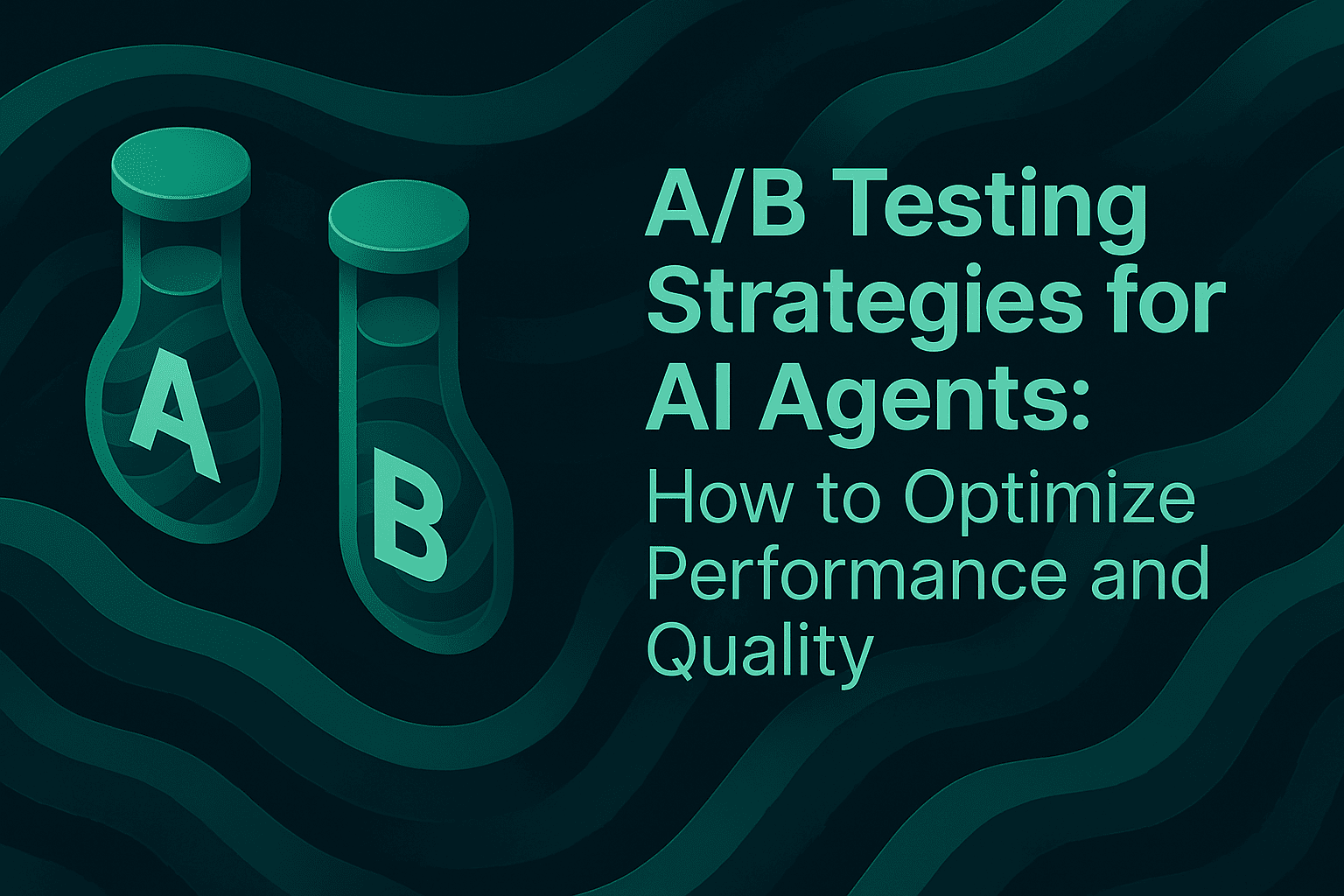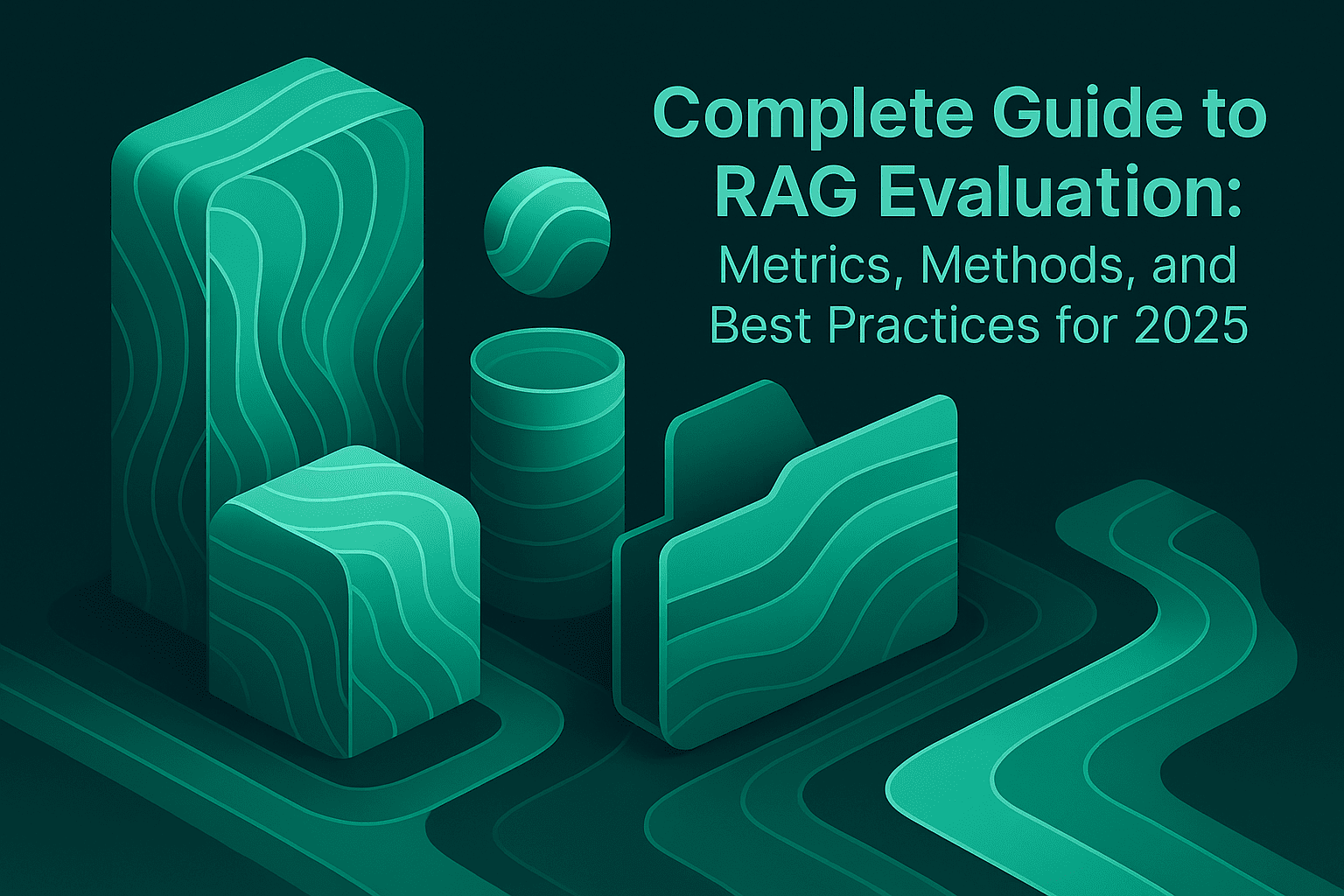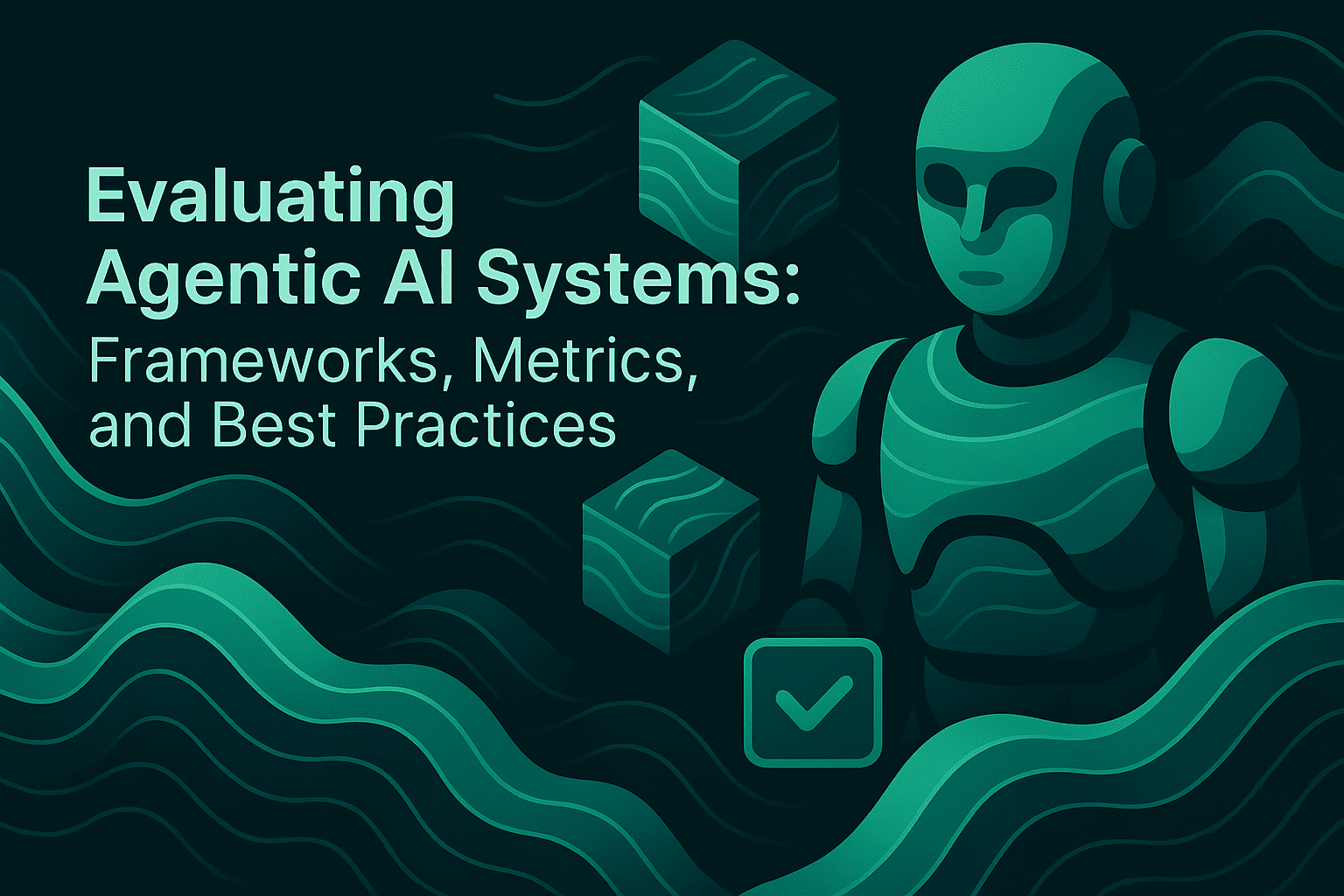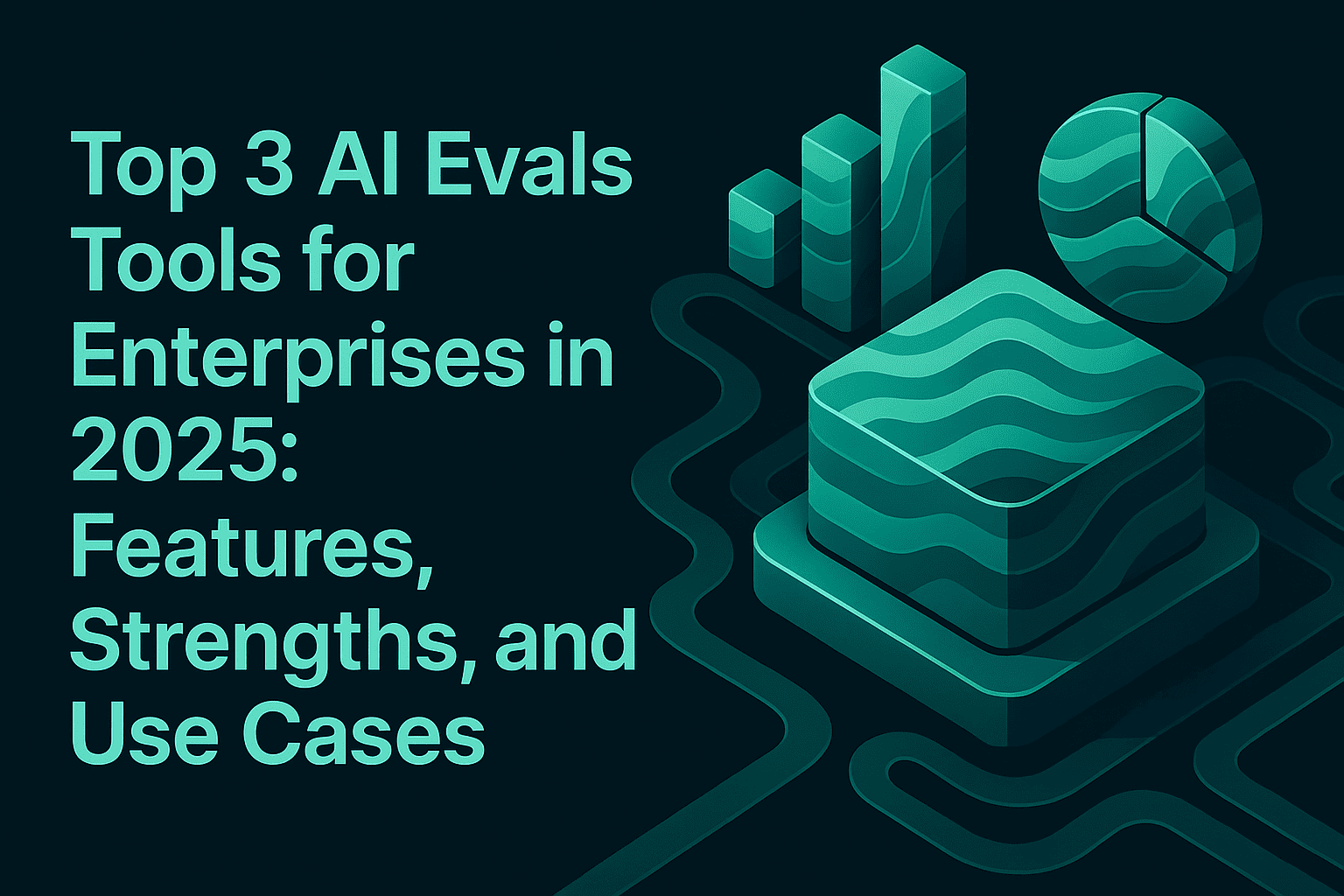A/B Testing Strategies for AI Agents: How to Optimize Performance and Quality

A/B testing has evolved from a simple website optimization technique to a critical methodology for evaluating and improving AI agent performance. As enterprises deploy increasingly sophisticated agentic AI systems, traditional testing approaches often fall short. AI agents are transforming A/B testing from a blunt instrument into a precision tool, enabling organizations to conduct more sophisticated experiments, analyze data at scale, and make real-time decisions that optimize both performance and quality.
The challenge is substantial. According to recent industry research, delivering reliable, high-performing LLMs and agents remains challenging due to heterogeneous stacks, non-deterministic behavior, and cost sensitivity across multi-cloud runtimes. This complexity demands rigorous experimentation frameworks that balance statistical rigor with operational efficiency.
Understanding A/B Testing for AI Agents
A/B testing for AI agents involves comparing two or more variants of an AI system to determine which performs better based on predefined metrics. Unlike traditional software testing where outcomes are predictable and errors can be debugged through specific code blocks, LLMs operate as black boxes with infinite possible inputs and corresponding outputs, making evaluation inherently complex.
The Unique Challenges of Testing AI Agents
AI outputs are non-deterministic and subjective. The same prompt can produce different responses, and quality depends on context, user intent, and domain-specific requirements. This non-deterministic nature introduces several challenges:
Stochastic Outputs: Unlike traditional A/B tests where a button click is binary, AI agent responses vary even with identical inputs. This variability requires larger sample sizes and more sophisticated statistical methods to achieve confidence in results.
Multi-Dimensional Quality: AI agent performance cannot be reduced to a single metric. Quality encompasses accuracy, relevance, safety, latency, cost, and user satisfaction simultaneously. Optimizing one dimension may inadvertently degrade another.
Context Dependency: Agent behavior depends heavily on conversation history, user attributes, and environmental factors. Testing must account for these contextual elements to ensure results generalize to production scenarios.
Essential A/B Testing Methodologies for AI Agents
Traditional A/B Testing Framework
Traditional A/B testing allocates traffic equally between variants and collects data over a predetermined period. When running A/B tests, you must run the two variations simultaneously to avoid confounding variables like timing or seasonal effects.
For AI agents, the traditional approach follows this structure:
- Hypothesis Formation: Define what you're testing and expected outcomes. For example, "Adding few-shot examples to the prompt will increase task completion rate by 15%."
- Sample Size Determination: Use standard A/B testing power analysis to determine user sessions required for statistical significance, accounting for the stochastic nature of LLM outputs.
- Consistent Assignment: Assign users to control or treatment groups consistently throughout the experiment to prevent contamination.
- Statistical Analysis: For continuous metrics like average rating, use t-tests or non-parametric equivalents. For binary outcomes like success/failure, apply chi-square or two-proportion z-tests.
According to Kameleoon's 2025 Experimentation-led Growth Report, companies expecting significant growth were more likely to have mature experimentation strategies and unified testing processes, highlighting the importance of structured approaches.
Multi-Armed Bandit (MAB) Testing
Multi-armed bandit algorithms dynamically allocate traffic toward better-performing variations during the experiment, maximizing business value while still gathering statistical evidence.
The MAB approach differs fundamentally from traditional A/B testing:
Dynamic Traffic Allocation: Instead of equally splitting traffic throughout the test, MAB algorithms quickly identify frontrunner variants and incrementally direct more traffic to these variants, boosting performance before the test concludes.
Exploration-Exploitation Balance: MAB balances exploration (testing variants to improve estimates) with exploitation (sending traffic to the currently best-performing variant) to minimize opportunity cost during experimentation.
Continuous Optimization: MAB can be used for long-term optimization where poorly-performing arms are removed and replaced with new variants, enabling continuous testing and improvement.
A practical example: Amma, a pregnancy tracker app, used MAB algorithms to optimize push notifications, increasing retention by 12% across iOS and Android users while automating the optimization process.
Contextual Bandit Testing
Contextual bandits extend the MAB framework by using additional information about users, variants, and the environment to make personalized decisions. This enables true 1:1 personalization rather than finding a single global winner.
Context Utilization: The algorithm considers user attributes (purchase history, preferences, demographics), variant features (style, messaging, format), and environmental factors (time of day, device type, holidays) when making decisions.
Personalized Optimization: Unlike MAB which treats all customers the same, contextual bandits can learn that different variants perform better for different user segments, enabling sophisticated personalization at scale.
Real-World Application: Bain & Company reports that retailers using contextual bandits for offer optimization realize double-digit sales increases by continuously adapting to changing market conditions and customer preferences.
Key Metrics for Evaluating AI Agent Performance
Task-Specific Performance Metrics
Task-specific metrics measure criteria unique to your application. For customer support agents, this might include problem resolution rate; for code generation agents, it's code compilation and test passage rates; for summarization agents, it's capturing key points from source material.
Accuracy and Correctness: Measures how often the agent produces factually correct outputs. This is fundamental but insufficient alone, as correct answers can still be unhelpful or inappropriately formatted.
Task Completion Rate: Tracks the percentage of user interactions where the agent successfully completes the intended task. This end-to-end metric captures both technical correctness and practical utility.
Relevance: Assesses whether responses directly address user queries and provide useful information. An accurate but irrelevant response fails to deliver value.
Quality and Safety Metrics
Responsible AI metrics include bias, toxicity, and fairness and should be tested regardless of the task at hand. An LLM should not produce biased content even when explicitly asked to do so.
Hallucination Detection: Measures the frequency of fabricated or unsupported claims in agent outputs. Techniques like SelfCheckGPT can automatically detect hallucinations by checking consistency across multiple generations.
Safety and Compliance: Evaluates whether outputs adhere to content policies, regulatory requirements, and ethical guidelines. This includes detecting toxic language, personally identifiable information leakage, and policy violations.
Bias and Fairness: Research shows that diversity-aware evaluation reduced gender bias in HR screening tools by 64%, demonstrating how measurement enables mitigation.
Operational Performance Metrics
Performance testing focuses on tokens per second (inference speed) and cost per token (inference cost) to optimize for latency and cost efficiency.
Latency: Response time directly impacts user experience. Even technically superior variants may fail if they're too slow for practical use.
Cost: Token consumption and API expenses must be balanced against quality improvements. A variant that's 5% better but 50% more expensive may not justify deployment.
Throughput: System capacity to handle concurrent requests becomes critical at scale. Testing must validate performance under realistic load conditions.
Statistical Approaches for LLM Evaluation
Model-Based Evaluation Metrics
Model-based scorers rely on another LLM to calculate scores of the tested LLM's output, enabling "AI evaluating AI" scenarios that scale better than purely manual evaluation.
G-Eval and LLM-as-Judge: These approaches use powerful models like GPT-4 to assess outputs on dimensions like coherence, relevance, and fluency. While faster and more cost-effective than human evaluation, they can be unreliable due to LLM non-determinism and potential biases.
Semantic Similarity Metrics: BERTScore uses pre-trained language models to compute cosine similarity between contextual embeddings, providing measures that correlate with human judgment at both sentence and system levels.
Balanced Approach: Use code-based scorers whenever possible because they're faster, cheaper, and deterministic. Reserve LLM-based scorers for subjective criteria that code cannot capture, such as tone, creativity, and nuanced accuracy.
Statistical Scoring Methods
Statistical scorers analyze LLM performance based on purely statistical methods that calculate the delta between actual versus expected output.
BLEU and ROUGE Scores: These measure n-gram overlap between generated and reference texts. BLEU evaluates precision (what percentage of generated n-grams appear in references) while ROUGE focuses on recall (what percentage of reference n-grams appear in generated text).
Limitations: Statistical methods don't excel at considering semantics and struggle with reasoning tasks or long, complex outputs. They work best for structured tasks with clear reference answers.
Practical Application: In A/B testing OpenAI LLMs, researchers used BLEU scores with Wilcoxon signed-rank tests to determine statistical significance, finding that GPT-3.5-turbo-0125 achieved the highest average performance on their test data.
Ensuring Statistical Validity
Define measurable hypotheses with specific success criteria. For example, "Adding an example to the prompt will increase correct answer rates by 5%." This clarity guides metric selection and statistical testing.
Power Analysis: Calculate required sample size before testing to ensure adequate statistical power. Underpowered tests waste resources without producing actionable insights.
Avoid Peeking: Use p-values and confidence intervals responsibly; avoid stopping tests early as soon as differences appear. Premature stopping inflates false positive rates.
Practical Significance: Even statistically significant improvements may lack practical relevance. A 3% quality increase that requires 50% more cost may not justify deployment.
Maxim's experimentation platform enables rigorous A/B testing by allowing teams to deploy different prompt variants, compare output quality across models and parameters, and make data-driven decisions based on quantitative metrics.
Implementing Effective A/B Tests for AI Agents
Test Design and Planning
According to research on AI agent performance, optimizing agent workflows by creating separate tasks that take about 30 minutes for a human to complete can increase success rates. This task decomposition principle applies to test design as well.
Define Clear Objectives: Start with specific, measurable goals. Rather than "improve the agent," specify "increase task completion rate by 10% while maintaining sub-2-second latency."
Select Appropriate Variants: Choose variants that test meaningful hypotheses. Compare fundamentally different approaches rather than trivial parameter tweaks that won't produce actionable insights.
Determine Test Duration: Run tests long enough to capture representative usage patterns while balancing the opportunity cost of prolonged experimentation.
Execution Best Practices
Consistent User Assignment: Assign users consistently to control or treatment groups to prevent contamination. Use deterministic hashing on user IDs to ensure repeatability.
Comprehensive Logging: Log user interactions, latency, and both direct and indirect quality signals. This data forms the backbone of statistical comparison and enables deeper post-hoc analysis.
Guardrail Metrics: Define metrics that must not degrade even if primary metrics improve. For example, safety scores and latency should remain within acceptable bounds regardless of accuracy gains.
Randomization Validation: Verify that randomization produces balanced groups across important covariates like user demographics, usage patterns, and device types.
Analysis and Interpretation
For continuous metrics, use t-tests or non-parametric equivalents. For categorical/binary outcomes, apply chi-square or two-proportion z-tests appropriate to your data distribution.
Multiple Testing Corrections: When evaluating multiple metrics simultaneously, apply corrections like Bonferroni or Benjamini-Hochberg to control family-wise error rates.
Segmentation Analysis: Metrics averaged across your test set can hide systematic failures on specific input types. Analyze score distributions and identify low-scoring subgroups that require targeted improvement.
Cost-Benefit Evaluation: Weigh performance improvements against implementation costs, ongoing operational expenses, and maintenance burden. Sometimes the simpler variant is the better choice.
Maxim's evaluation framework provides comprehensive tools for measuring agent quality using AI, programmatic, and statistical evaluators, enabling teams to quantify improvements across multiple dimensions simultaneously.
Advanced Testing Strategies
Simulation-Based Testing
Maxim's simulation capabilities enable teams to test AI agents across hundreds of scenarios and user personas before production deployment, reducing the risk of costly failures.
Scenario Coverage: Simulate customer interactions across diverse real-world situations, from common happy paths to edge cases and adversarial inputs. This pre-production testing identifies failure modes early.
Trajectory Analysis: Evaluate agents at the conversational level by analyzing the decision paths taken. Assess whether tasks completed successfully and identify specific interaction points where failures occur.
Root Cause Analysis: Re-run simulations from any step to reproduce issues, enabling systematic debugging and validation of fixes without impacting real users.
Continuous Monitoring and Online Evaluation
Run metrics on production traffic with appropriate sampling rates to detect quality degradation in real-time and alert when scores drop below thresholds.
Automated Quality Checks: Configure evaluators to run continuously on production data. Set up multiple rules with different sampling rates, prioritizing inexpensive metrics at higher rates and expensive LLM-based metrics at lower rates.
Anomaly Detection: Establish baselines for key metrics and trigger alerts when deviations exceed acceptable thresholds. Respond before users notice problems.
Feedback Integration: Collect examples of successful and problematic interactions to continuously improve evaluation datasets and refine agent behavior based on real-world performance.
Maxim's observability suite provides real-time monitoring, distributed tracing, and automated evaluations to ensure production AI systems maintain quality standards.
Multi-Variate and Sequential Testing
Multivariate testing splits audiences among different variants to identify optimal combinations, though it shares traditional A/B testing's limitations of equal allocation regardless of performance.
Factorial Designs: Test multiple factors simultaneously to understand interaction effects. This is more efficient than sequential single-factor tests but requires larger sample sizes.
Sequential Testing Approaches: Multi-armed bandits can be combined with sequential testing to optimize the trade-off between statistical power and efficiency, adapting traffic allocation as evidence accumulates.
Bayesian Approaches: The industry is moving toward Bayesian frameworks as they provide simpler, less restrictive, and more intuitive approaches to A/B testing compared to frequentist methods.
Enterprise-Scale A/B Testing Considerations
Tool Selection and Integration
According to the 2024 Marketing Technology Landscape report, the number of tools in the optimization, personalization, and testing segment increased significantly. Selecting the right platform depends on organizational maturity and requirements.
Unified Platforms: Mid-to-enterprise organizations benefit from unified platforms offering experimentation, and evaluation capabilities in a single system.
Integration Requirements: Ensure testing platforms integrate seamlessly with existing data infrastructure, analytics systems, and deployment pipelines. Poor integration creates friction that slows experimentation velocity.
Developer Experience: Evaluate platforms based on SDK quality, API completeness, and configuration flexibility. Solutions offering zero-config startup enable faster adoption across teams.
Maxim's platform integrates experimentation, evaluation, and observability in a unified interface, enabling cross-functional teams to collaborate seamlessly without constant engineering dependencies.
Organizational Best Practices
Companies expecting significant growth had mature experimentation strategies with streamlined workflows and higher productivity rates rather than replacing human judgment with automation.
Establish Experimentation Culture: Encourage hypothesis-driven development where new features and changes undergo rigorous testing before full deployment. Make experimentation a default rather than an exception.
Cross-Functional Collaboration: Involve domain experts, AI engineers, product managers, and QA teams in test design and analysis. Diverse perspectives improve hypothesis quality and interpretation.
Knowledge Sharing: Document learnings from both successful and failed experiments. Build institutional knowledge about what works in your specific context and domain.
Velocity Optimization: Identify bottlenecks in your experimentation workflow and streamline processes to increase test velocity. Faster iteration cycles accelerate learning and improvement.
Cost Management and ROI
Software teams spend 60-80% of test automation effort on maintenance, highlighting the importance of sustainable testing infrastructure that doesn't become a resource drain.
Budget Allocation: Balance investment across people, tools, and infrastructure. Companies that invest 75% or more of their budget on people, skills, and process rather than just tools deliver greater ROI.
Cost Monitoring: Track API usage, compute resources, and tooling subscriptions. Implement cost controls and budget alerts to prevent runaway expenses.
Value Measurement: Quantify the business impact of experimentation programs. Track metrics like revenue per user, conversion rates, and customer satisfaction to demonstrate ROI.
Common Pitfalls and How to Avoid Them
Technical Pitfalls
Insufficient Sample Sizes: Running metrics on 10 examples doesn't reveal patterns. You need hundreds to thousands of diverse test cases to reliably measure quality.
Metric Mismatch: Exact match doesn't work for open-ended questions. Match metrics to your use case rather than applying generic scoring blindly.
Ignoring Distribution: Score distributions often reveal more than averages. Analyze percentiles and identify cohorts where performance systematically fails.
Version Inconsistency: Scorer changes affect metric values. Track scorer versions alongside prompt versions to ensure valid comparisons.
Organizational Pitfalls
Over-Optimization: Optimizing only for factuality might produce dry, technically correct but unhelpful answers. Balance multiple quality dimensions rather than single-mindedly pursuing one metric.
Neglecting Guardrails: Failing to monitor safety, bias, and compliance metrics while optimizing for performance can lead to harmful deployments that damage user trust.
Premature Scaling: Deploying variants without adequate validation because early results look promising leads to expensive rollbacks. Maintain statistical discipline even when pressured to move quickly.
Ignoring User Feedback: Quantitative metrics don't capture everything. Incorporate qualitative user feedback through structured evaluation frameworks to maintain alignment with actual user needs.
Conclusion
A/B testing AI agents requires systematic approaches that account for the unique challenges of non-deterministic systems while maintaining statistical rigor. As organizations deploy increasingly sophisticated agentic applications, effective experimentation becomes the foundation for continuous improvement and reliable performance.
Success in AI agent testing depends on several critical factors:
- Selecting appropriate testing methodologies based on your goals, balancing traditional A/B tests with advanced approaches like multi-armed bandits and contextual bandits
- Defining comprehensive evaluation metrics that capture multiple quality dimensions including accuracy, safety, latency, and cost
- Implementing robust statistical analysis that accounts for LLM stochasticity while avoiding common pitfalls like insufficient sample sizes and premature optimization
- Establishing organizational practices that promote experimentation culture, cross-functional collaboration, and knowledge sharing
- Leveraging modern platforms like Maxim AI that integrate experimentation, evaluation, and observability in seamless workflows
Ready to transform your AI agent testing and optimization? Discover how Maxim AI's comprehensive platform can help your team ship reliable AI agents more than 5x faster through advanced experimentation, simulation, evaluation, and observability capabilities. Start your free trial today and experience the difference that systematic A/B testing makes in production AI systems.


